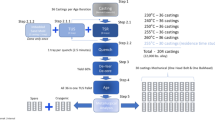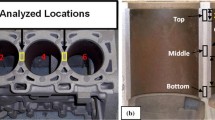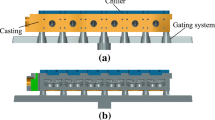Abstract
To minimize the carbon footprint of the transportation industry, manufacturers and engineers are continuously trying to improve the efficiency of the combustion engine. However, due to the presence of iron cylinder liners in the engine block, high tensile residual stresses are generated during the manufacturing process which leads to a large reduction of the alloy’s useable strength. Thus, the present study utilized neutron diffraction to study, for the first time, the evolution of residual stress of sand-cast aluminum engine blocks that have eliminated the iron cylinder liners from the casting process and mechanically inserted them after heat treatment and machining operations. Moreover, this study also examined the effects that cylinder bore chills have on the resulting residual stress profiles. The replacement of the iron liners shifted the stress mode from purely tension to purely compression until the bore chills were removed. Following the removal of the bore chills, the maximum tensile stress at the top of the cylinder bridge was ~ 70% lower than the engine’s predecessor which was produced with iron liners. Moreover, in the production-ready state (i.e., T7 heat treated and press-fit liners inserted), the stress mode maintains the partially compressive nature, thereby lowering the material’s susceptibility to crack growth and propagation.
Graphical Abstract


adapted from Byczynski and Mackay [12])














Similar content being viewed by others
Data availability
The raw and processed data required to reproduce these findings are available to download from Mendeley Data [“Data for Residual Stress in I6 Engine Blocks, http://dx.doi.org/10.17632/vz6krysd36.1”].
Code availability
Not applicable.
References
Suman C (1991) SAE Tech Pap Ser., no. 910416. https://doi.org/10.4271/910416
Barsom J and Rolfe S (1999) Fracture and fatigue control in structures: applications of fracture mechanics, 3rd edn. Am Soc Test Mat.
Sediako D, D’Elia F, Lombardi A, Machin A, Ravindran C, Hubbard C, Mackay R, Int SAE (2011) J Mater Manuf 4:1. https://doi.org/10.4271/2011-01-0036
Lombardi A, Ravindran C, Sediako D, MacKay D (2014) Metall Mater Trans A Phys Metall Mater Sci 45:13. https://doi.org/10.1007/s11661-014-2580-y
Lombardi A, Sediako D, Machin A, Ravindran C, MacKay R (2017) Mater Sci Eng A 697. https://doi.org/10.1016/j.msea.2017.05.026
Martyr AJ, Plint MA (2012) Engine testing: the design, building, modification and use of powertrain test facilities, 4th edn. (Elsevier Ltd) 375–406.
Kouremenos DA, Rakopoulos CD, Kotsos CG (1991) Forsch im Ingenieurwes 57:3. https://doi.org/10.1007/BF02561172
Zhang J, He XD, Sha Y, Du SY (2010) Int J Fatigue 32:2. https://doi.org/10.1016/j.ijfatigue.2009.07.008
Lombardi A, D’Elia F, Ravindran C, Sediako D, Murty BS, MacKay R (2012) Metall Mater Trans A 43:13. https://doi.org/10.1007/s11661-012-1340-0
Stroh J, Piche A, Sediako D, Lombardi A, Byczyinski G (2019) Light Metals (Springer). https://doi.org/10.1007/978-3-030-05864-7_65
Lombardi A (2011) Master’s Thesis, Ryerson University.
Byczynski G and Mackay R (2019) Shape Casting 7th International Symposium (Springer International Publishing). https://doi.org/10.1007/978-3-030-06034-3_18
Cornwell P, Bunn J, Fancher CM, Payzant EA, Hubbard CR (2018) Rev Sci Instrum 89:9. https://doi.org/10.1063/1.5037593
Roy T, Paradowska A, Abrahams R, Law M, Mutton P, Soodi M, Yan W (2020) J Mater Process Technol 278:116511. https://doi.org/10.1016/j.jmatprotec.2019.116511
Hutchings M, Withers P, Holden T, Lorentzen T (2005) Introduction to the characterisation of residual stress by neutron diffraction. Taylor, Boca Raton, FL
Holden T (2013). Practical residual stress measurement methods. https://doi.org/10.1002/9781118402832.ch8
Stroh J, Sediako D, Byczynski G, Lombardi A, Paradowska A (2020) Light Metals. (Springer, 2020). https://doi.org/10.1007/978-3-030-36408-3_21
Dong C, bin Wu H, tao Wang XJ (2019) Iron Steel Res Int 26:8. https://doi.org/10.1007/s42243-019-00283-1
Liu T, Brewer L, Bunn J, Fancher C, Nastac L, Arvikar V, Levin I (2019) Miner Met Mater Ser. https://doi.org/10.1007/978-3-030-06034-3_29
Carrera E, Rodríguez A, Talamantes J, Valtierra S, Colás RJ (2007) Mater Process Technol 189. https://doi.org/10.1016/j.jmatprotec.2007.01.023
Satyanarayana K, Hanumantha Rao TV, Niranjan Kumar I, Mohan Rao PVJ, Prasad VVS (2018) Mater Today Proc 5:9. https://doi.org/10.1016/j.matpr.2018.06.311
Garat M (2010) Fonderie Magazine 2
Osmond P, Le VD, Morel F, Bellett D, Saintier N (2018) Procedia Eng 213. https://doi.org/10.1016/j.proeng.2018.02.059
Cao H, Luo Z, Wang C, Wang J, Hu T, Xiao L, Che J (2020) Materials 13:3019. https://doi.org/10.3390/ma13133019
Gao YX, Yi JZ, Lee PD, Lindley TC (2004) Fatigue Fract Eng Mater Struct 27:7. https://doi.org/10.1111/j.1460-2695.2004.00780.x
Acknowledgements
The authors would like to gratefully acknowledge the support provided by the High Flux Isotope Reactor, a DOE Office of Science User Facility operated by the Oak Ridge National Laboratory. The authors would like to specifically thank local ORNL scientists Dr. Jeffrey Bunn and Dr. Chris Fancher. Finally, the authors sincerely appreciate the contribution from Dr. Houman Alipooramirabad and the entire research team at the High Performance Powertrain Materials laboratory.
Funding
This work was funded by Dr. Dimitry Sediako’s Natural Science and Engineering Research Council (NSERC)—Collaborative Research and Development (CRD) grant (CRDPJ5377770-18, Development of Aluminum Casting and FSW Technologies for Next-Gen Automotive Powertrains). The research described in this paper was supported by funding from the Australian Nuclear Science and Technology Organisation (ANSTO) through Proposals DB8083 and P7274.
Author information
Authors and Affiliations
Contributions
All authors contributed to the study conception and design. Material preparation was performed by Joshua Stroh, Dimitry Sediako, Anthony Lombardi, and Glenn Byczynski. Data collection and analysis were performed by Joshua Stroh, Dimitry Sediako, Mark Reid, and Anna Paradowska. The first draft of the manuscript was written by Joshua Stroh, and all authors commented on all versions of the manuscript. All authors read and approved the final manuscript.
Corresponding author
Ethics declarations
Ethics approval
Not applicable.
Consent to participate
All authors give consent to participate in the study and its subsequent publication.
Consent for publication
All authors consent to publication.
Conflict of interest
The authors declare no competing interests.
Additional information
Publisher's Note
Springer Nature remains neutral with regard to jurisdictional claims in published maps and institutional affiliations.
Rights and permissions
About this article
Cite this article
Stroh, J., Sediako, D., Lombardi, A. et al. Evolution of residual stress through the processing stages in manufacturing of bore-chilled sand-cast aluminum engine blocks with pressed-in iron liners. Int J Adv Manuf Technol 120, 4693–4705 (2022). https://doi.org/10.1007/s00170-022-09059-6
Received:
Accepted:
Published:
Issue Date:
DOI: https://doi.org/10.1007/s00170-022-09059-6




